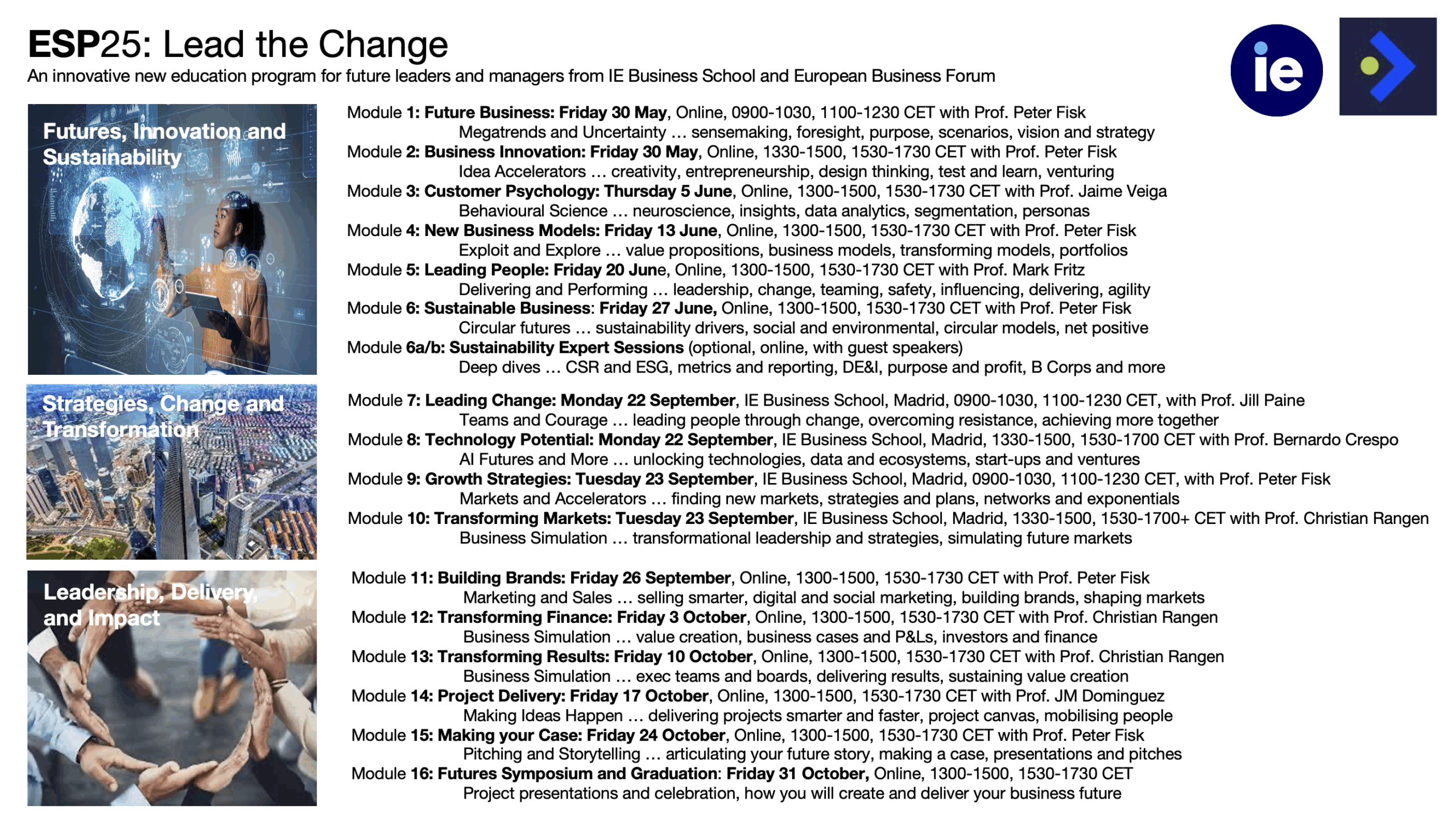Lead the Change: Leading Change
September 22, 2025 at ESP25 at IE Business School, Madrid

Incredible technologies and geopolitical shifts, complex markets and stagnating growth, demanding customers and disruptive entrepreneurs, environmental crisis and social distrust, unexpected shocks and uncertain futures.
For every business leader, the challenge is about making sense of today’s rapidly changing world, and understanding how to prepare for, and succeed, in tomorrow’s world.
We explore how businesses can survive and thrive, and move forwards to create a better future. How to reimagine business, to reinvent markets, to reengage people. We consider what it means to combine profit with more purpose, intelligent technologies with creative people, radical innovation with sustainable impact.
We learn from the innovative strategies of incredible companies – Alibaba and ASML, Biontech and BlackRock, Canva and Collossal, NotCo and Netflix, Patagonia and PingAn, Spotify and Supercell, and many more. We also take a look at what this means for insurance, and some of the most innovative companies in the field.

Are you ready to seize the opportunities of a changing world?
How will you – and your strategy, organisation, people and projects – embrace the challenges and opportunities of change ahead of us? Where are your biggest opportunities for innovation and growth? What are your priorities to balance short and longer term? How will you behave as a manager and leader?
We’ve developed a new program for business leaders, managers of companies large and small, to get up to speed with the very latest ideas, tools and approaches to business, learning from companies and experts around the world. It’s called the Executive Management Program, delivered as a hybrid program online and in face to face in Madrid.
It’s like a Mini MBA, but fit for today’s world, where challenges like economic uncertainty and climate change are matched by opportunities like the applications of AI and new business models. It includes an exciting dynamic business simulation, about managing and leading change, plus insights and ideas from the world’s most interesting companies, right now.
In fact it brings together much of the Global Online MBA from IE Business School, which is ranked #1 in the world, and in particularly for topics such as ESG and sustainability. The faculty is made up of expert professors from IE and beyond, and we spend a number of days in Madrid at IE’s Executive Education campus.
For more info, contact me directly: peterfisk@peterfisk.com

Module 7: Leading Change
In today’s world of accelerated disruption, climate imperatives, digital revolutions, and shifting customer expectations, leading change has become one of the most critical—and complex—challenges facing business leaders. Change is no longer a discrete event to be managed occasionally; it is a continuous state, a new normal in which adaptability and vision are key determinants of success.
To lead change effectively now means guiding your organization through uncertainty, aligning diverse teams behind a shared future, and orchestrating transformation across products, platforms, people, and processes—all while delivering performance today. It requires clarity, empathy, and the courage to embrace ambiguity. Most of all, it means creating the conditions in which step-change innovation and value creation can flourish.
Change has changed
Traditional change management approaches—top-down, project-based, process-heavy—are too slow and rigid for today’s pace of change. Businesses are now dealing with concurrent disruptions: technological advancements, shifting customer behaviors, new regulations, talent shortages, and geopolitical shocks. These forces do not arrive one at a time; they converge, amplify, and evolve unpredictably.
Transformation is no longer confined to IT systems or cost structures. It now touches everything at once: business models, customer relationships, culture, talent, ESG performance, innovation pipelines, and organizational purpose. Change is systemic, dynamic, and often existential.
Companies like Microsoft, Schneider Electric, and Ping An have shown that leading change is not about reacting to trends—it’s about shaping them. It’s about seeing further, moving faster, and inspiring deeper engagement.
Transformation is a journey of many changes
True transformation rarely happens overnight. It’s a journey that unfolds over time, typically through a series of interrelated changes that reinforce each other. These may include:
-
Redefining the business strategy to focus on future growth areas
-
Evolving the operating model to support speed, agility, and innovation
-
Embedding digital technologies to unlock new capabilities
-
Shifting culture and leadership behaviors to foster creativity and accountability
-
Building new skills, partnerships, and ecosystems
-
Rewiring governance and decision-making to be more dynamic and inclusive
Each of these steps is significant on its own. Taken together, they reshape the DNA of the business.
For example, Fujifilm’s transformation from a photo film business into a diversified health and high-tech materials company took more than a decade. It was driven by a portfolio of changes—investments in new R&D, the acquisition of medical companies, the divestment of legacy operations, and a culture that supported long-term reinvention.
Transformation is not about quick wins—it’s about durable shifts that create future-facing value.
Leading Through Uncertainty: Vision and Anchoring
In periods of intense uncertainty, people crave clarity. One of the most important roles of a change leader is to anchor the organization in a compelling vision of the future—a North Star that helps people make sense of change and feel confident in the direction.
This vision must be ambitious enough to inspire, but concrete enough to guide decision-making. It should articulate not just what will change, but why—the strategic rationale, the opportunity being pursued, and the kind of organization you’re building together.
Satya Nadella’s early years at Microsoft illustrate this well. His reframing of Microsoft’s mission (“to empower every person and every organization on the planet to achieve more”) and focus on a growth mindset culture gave the company a refreshed identity, while also setting the stage for deep business and cultural transformation.
Vision provides the compass. But to navigate uncertainty, leaders must also create safety—psychological safety, career safety, and organizational safety. People need to know they are not being left behind, that they are supported through ambiguity, and that risk-taking is valued.
Engaging People in the Change
Change is ultimately about people. No transformation succeeds without the engagement, belief, and energy of the workforce. This requires leaders to listen deeply, communicate frequently, and act visibly.
-
Co-create the journey: Involve people at all levels in shaping solutions. This builds ownership, surfaces insights, and accelerates learning.
-
Tell human stories: Use stories to bring the vision to life. Share real examples of teams trying new things, overcoming setbacks, and creating impact.
-
Recognize and reward: Celebrate progress and acknowledge those who model the new behaviors. Culture changes one conversation, one decision, one story at a time.
-
Equip for change: Invest in upskilling, reskilling, and digital literacy. Help people move from fear of change to fluency with change.
When people are part of the transformation—not just subject to it—they become its champions.
Aligning Organizations and Processes
Leading change means aligning the hard and soft systems of the organization to support the new direction. This includes:
-
Structure: Move from siloed hierarchies to cross-functional networks that allow ideas and decisions to flow faster.
-
Processes: Streamline governance and shift from annual planning to agile, iterative cycles that can respond to change in real-time.
-
Metrics: What gets measured gets managed. Align KPIs with the desired outcomes of transformation—innovation speed, customer satisfaction, carbon reduction, talent mobility—not just legacy financials.
-
Technology: Make tech a strategic enabler. Invest in platforms, data, and automation that increase speed, personalization, and scale.
Schneider Electric aligned its organizational design, leadership development, and customer experience metrics to support its repositioning as a digital sustainability partner. This alignment enabled it to deliver both top-line growth and impact, helping it to consistently rank among the world’s most sustainable and admired companies.
Creating step-change innovation and value
At its best, transformation leads to step-change innovation—new products, new markets, new ways of working—and transformational value creation. This isn’t about 10% improvements; it’s about unlocking new strategic possibilities.
Ping An, the Chinese financial giant, created entirely new ecosystems in health, fintech, and smart city services by fusing data, AI, and platforms. It moved from traditional banking and insurance to a digitally integrated enterprise with multiple value engines.
What made this possible? Clear vision, long-term leadership commitment, organizational integration, and the courage to redefine itself in a fast-moving landscape.
Innovation at this scale requires leaders to create the conditions for creativity and experimentation—psychological safety, time, tools, and trust. It also requires discipline: innovation must align with strategy, be customer-centric, and scale effectively.
Leadership in a changing world
Finally, leading change begins with leading oneself. In fast-changing environments, leaders must constantly evolve. They must cultivate humility, curiosity, resilience, and emotional intelligence. They must move from command-and-control to coach and catalyze.
The best change leaders are not heroic figures at the top, but enablers of change at every level. They ask better questions, unlock others’ potential, and make space for new thinking to emerge.
To lead change today is to lead through uncertainty with purpose. It means seeing transformation not as a threat, but as an opportunity to reimagine what your organization can become. It means aligning vision, strategy, systems, and people into a coherent whole that can learn, adapt, and grow faster than the world around it.
And above all, it means believing in the possibility of better—a more innovative, sustainable, inclusive, and valuable future—and helping others believe it too.
Find out more and book >